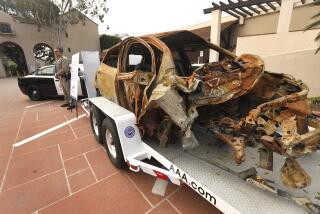Report: Drowsy driving is dangerous -- and common
- Share via
In more than 20 years as a driver, I’ve been involved in two scary freeway accidents. The first was on an icy evening in Vermont. I was a passenger in a car at the end a day on the ski mountain. The second wreck took place on a splendid warm afternoon, on the 405 Freeway in Los Angeles. That time I was the one driving, headed home after a long bike ride in Irvine.
In both cases, drivers fell asleep at the wheel (yes, that includes me). Luckily, no one was hurt -- though three different automobiles and one mangled bicycle would never be the same.
Unfortunately, such clean getaways aren’t inevitable when it comes to drowsy driving.
A new analysis, published Thursday in the U.S. Centers for Disease Control’s Morbidity and Mortality Weekly Report, examined survey data from nearly 150,000 drivers in 19 states and the District of Columbia and found that 4.2% admitted having fallen asleep while driving in the last 30 days.
Men were more likely to report nodding off at the wheel than women; younger drivers were more likely to have done so than older ones (for more on young drivers’ propensity for sleeping while driving, check out the related items at left.) Prevalence of drowsy driving was highest in Texas, at 6.1%, and lowest in Oregon, at 2.5%.
The results of the study, the largest yet to examine the prevalence of drowsy driving, supported earlier research, which also had shown that around 4% of respondents fell asleep while driving in the previous year (and in one case, 11% in the previous year).
Lead author Anne G. Wheaton of the CDC and her collaborators also cited National Highway Traffic Safety Administration statistics showing that 2.5% of all fatal motor vehicle crashes (around 730 in 2009) involved drowsy driving, as did around 2% of crashes that resulted in non-fatal injuries (around 30,000 in 2009). They noted also that earlier research had shown that drowsy driving accidents are more likely to result in injuries and deaths than non-drowsy driving crashes.
The team provided some advice for preventing drowsy driving. “Drivers should ensure that they get enough sleep (7-9 hours), seek treatment for sleep disorders, and refrain from alcohol use before driving,” they wrote. They also seconded NHTSA’s suggestion that employers of shift workers (anyone who works beyond a typical work day) provide transportation for those workers or allow them to nap at work.
Here’s the recommendation that I’ll try to remember: If you feel symptoms of drowsiness — frequent yawning or blinking, drifting out of the lane, the rumble of the bumpy pavement on the shoulder of the road — it’s time to stop operating that vehicle.
“The only safe thing for drivers to do if they start to feel tired while driving is to get off the road and rest,” the authors wrote, adding that increasing radio volume, opening windows and cranking up the air conditioning are not effective ways to stay awake.







